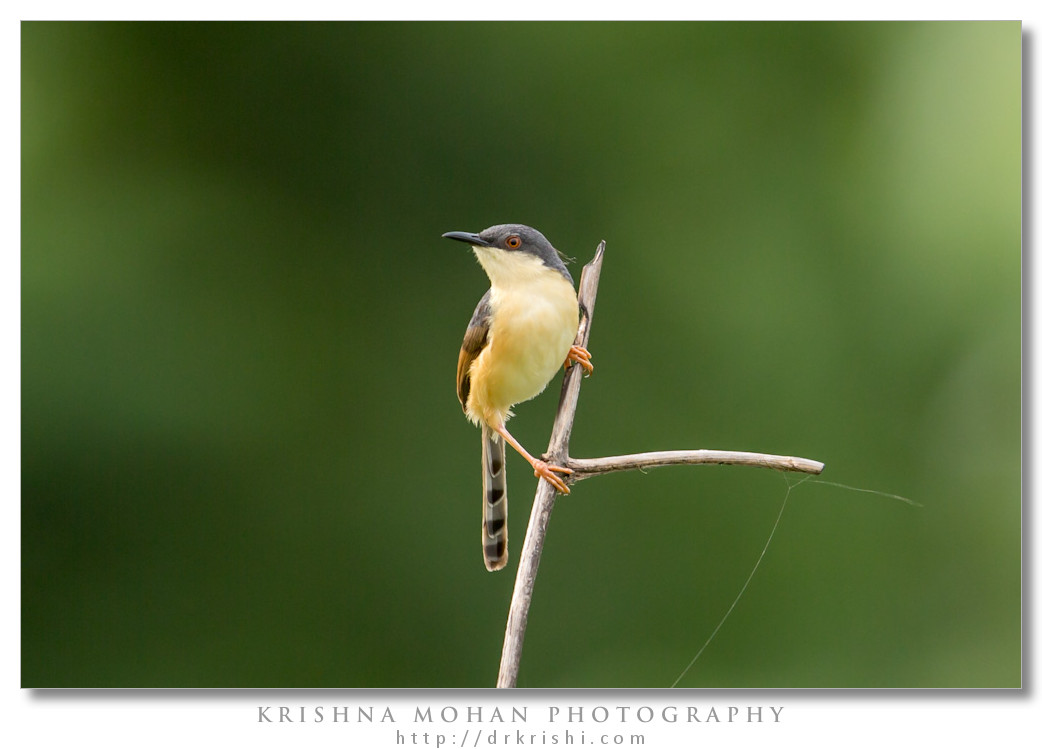
On that evening I found this lovely Ashy Prinia sitting on a dry twig singing nicely. I was photographing using my newly acquired Canon EOS 5D Mark III along with Canon EF 300mm f/2.8L IS USM fitted with Canon EF 1.4x III Extender. Illumination for this bird was from diffuse sunlight peeping out of clouds from the camera left which gave a very nice wrap around the bird. Rains were yet to start and few pre-monsoon showers had rendered the background lush green. To make my background as smooth as possible I turned to aperture priority mode and dialed it to f/5.0. Wide aperture along with 420mm focal length gave me this nice bokeh. ISO was at auto and camera guessed it at 160. I could get shutter speed of 1/500 and 1/400th of second. With 5D Mark III I can safely go for a higher ISO without much noise. I prefer Auto ISO in rapidly changing light situation with a limit to the maximum ISO the camera can go implemented. For 5D Mark III I can go maximum to ISO 3200 or even 6400. If I am using Canon EOS 7D I restrict only to 1600 as the low high ISO on that produces unacceptable noise.

The Ashy Prinia or other wise known as Ashy Wren-Warbler (Prinia socialis), is a small warbler. This prinia is a resident breeder in the Indian Subcontinent, ranging across most of India, Nepal, Bangladesh, Bhutan, Sri Lanka and western Myanmar. The species is absent from the dry desert zone of the west of India. It is a common bird in urban gardens and farmland in many parts of India and its small size, distinctive colors and upright tail make it easy to identify. The northern populations have a rufus rump and back and have a distinct breeding and non-breeding plumage while other populations lack such variation.

These 13–14 cm long warblers have short rounded wings and longish graduated cream tail tipped with black subterminal spots. The tail is usually held upright and the strong legs are used for clambering about and hopping on the ground. They have a short black bill. The crown is grey and the underparts are Rufus in most plumages. They are found singly or in pairs in shrubbery and will often hop on the ground searching for insects.

This passerine bird is found in dry open grassland, open woodland, scrub and in home gardens in many cities. Like most warblers, the Ashy Prinia is insectivorous. The song is a repetitive zeet-zeet-zeet. Another call is a nasal tee-tee-tee. It also makes a sound like “electric sparks” during the fluttery flight. The non-migratory Prinia genus shows biannual moult which is rare among passerines. A moult occurs in spring (April–May) and another moult occurs in autumn (October–November).

The song is delivered from the top of a bush and males make fluttery display flights with the tail held up. The Ashy Prinia builds its nest close to the ground in a shrub or tall grass and lays 3-5 eggs. Several types of nests have been described including a flimsy cup made by sewing several large leaves; an oblong purse like structure with grass stems in the structure; and a flimsy ball of grass. The usual nest is placed low in a bush and consists of leaves stitched together with webs, lined with hair and having an entrance on the side. The eggs are of a somewhat pointed oval form and exceedingly glossy. They vary from brick-red to rich chestnut in color, some being paler, some darker. The broad end of the egg is generally darker than the remainder of the shell, and exhibits a cap or zone.The eggs hatch in about 12 days.

The species is believed to be monogamous and both the male and the female take part in incubation and feeding though to varying extents. Parents may spend more time at the nest during cool days. Cuckoos Cacomantis merulinus and Cacomantis passerinus have been known to be brood parasites of this species. When the nest is threatened by predators such as cats or humans adults have been observed feigning injury. Here are my earlier posts on this bird Ashy Prinia, More Ashy Priniae and Prinia On the Fence


simply beautiful!
http://amazingwondersinmylife.blogspot.in/
Very good photo. I was trying to photograph an ashy prinia, but it never came out in the open. When it did finally, I switched off my camera by mistake. By the time it went off and on, the ashy prinia was gone and I was thoroughly fryustrated
Very excellent pic sir,